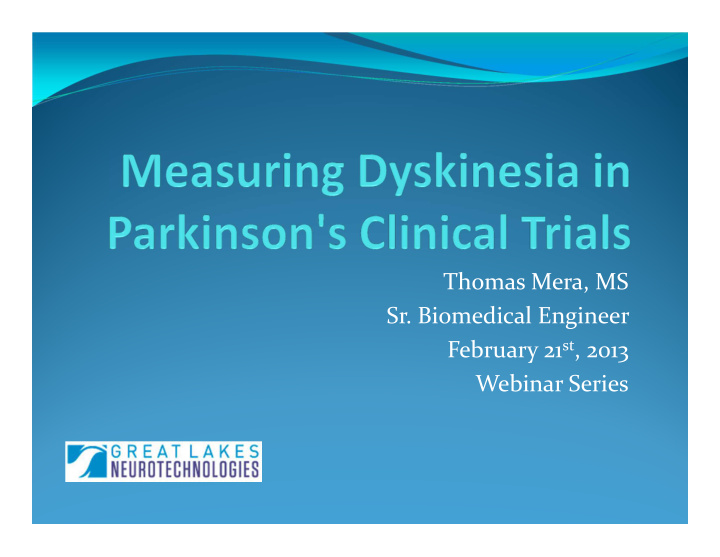



Thomas Mera, MS Sr. Biomedical Engineer February 21 st , 2013 Webinar Series
Question 1: How are PD motor complications evaluated in 1. clinical trials? What are the challenges with clinical trial dyskinesia 2. endpoints, and how can they be improved? How can home-based motion sensor dyskinesia 3. assessment improve your clinical trials?
Motor Complications of Chronic Levodopa Therapy Advanced Stages Motor fluctuations 1. Alternate between � therapy “off” and “on” states over dose cycles Levodopa-induced 2. dyskinesia (LID) Involuntary, episodic, � and irregular movements � Peak-dose most common Keijsers, N. L., M. W. Horstink, et al. (2003). "Automatic assessment of levodopa- induced dyskinesias in daily life by neural networks." Mov Disord 18 (1): 70-80.
Question 2: How are PD motor complications evaluated in 1. clinical trials? What are the challenges with clinical trial dyskinesia 2. endpoints, and how can they be improved? How can home-based motion sensor dyskinesia 3. assessment improve your clinical trials?
Clinical Trial Review
Clinical Trial Endpoints � Clinical Assessments � UPDRS, UDysRS, mAIMS, PDYS- 26 � Patient retrospective recall � Patient diaries � Self assessment at home � 0.5-1 hr interval diary entries � Body-worn motion sensors � Shift in research � Unconstrained continuous assessment at home Transition to clinical trial use not � trivial Importance of quality assurance (e.g. � FDA, ISO, CE, TGA)
Challenges with Clinical Trial Endpoints � Resolution of clinical rating scales � Severity: 0-4 integer scoring � Temporal: snapshot of dyskinesia response � Compliance of home diaries � Correlation between reported and actual compliance � Patient awareness of, understanding, and recognizing therapy states � Costs � Clinician and patient time in clinic � Accuracy may affect statistical power
Motion Sensor LID Assessment: Clinical Validation Study � Collaborators � Michelle Burack, MD, PhD � NIH-funded SBIR Phase I � Goals Capture peak-dose dyskinesia over a levodopa dose 1. using hand-worn motion sensors Develop a scoring model to automatically rate 2. dyskinesia Determine whether a single motion sensor unit could 3. accurately assess global dyskinesia
Methods: Study Preparation � Off levodopa from previous night or end of dose � A wireless motion sensor unit positioned on each hand � Two discrete motor tasks: Arms resting 1. Arms Extended 2. � Serial subtractions as distraction
Methods: Data Collection � Two motor tasks at hours 0, 1, 2, and 3 after levodopa dose � Motion sensor data were wirelessly streamed to a computer � Video of task performance was recorded and later scored by two expert raters � modified-Abnormal Involuntary Movement Scale (m-AIMS) � 0 (none) to 4 (severe) global dyskinesia ratings � Severity scoring models developed using sensor data and clinician global m-AIMS scores
Clinical Assessment Arms Extended Task The time to reach peak-dose dyskinesia varied by subject
Symptom Feature Extraction
Dyskinesia Severity Scoring Model
Question 3: How are PD motor complications evaluated in 1. clinical trials? What are the challenges with clinical trial dyskinesia 2. endpoints, and how can they be improved? How can home-based motion sensor dyskinesia 3. assessment improve your clinical trials?
Clinical Trial Drug Comparison PD Motor Symptom Severity
Advantages For Your Clinical Trials Motion sensor assessment during discrete tasks � Clinical validation and quality assurance � Home assessment kit � Single motion sensor to assess global dyskinesia fluctuations � Electronic formatting Instant access, reports �
Advantages For Your Clinical Trials Motion sensor assessment during discrete tasks � Clinical validation and quality assurance � Home assessment kit � Single motion sensor to assess global dyskinesia fluctuations � Electronic formatting � Instant access, reports
References � Hoff JI, van Hilten BJ, and Roos RA (1999) A review of the assessment of dyskinesias. Mov Disord 14 , 737-43. � Amanzio M, Monteverdi S, Giordano A, Soliveri P, Filippi P, and Geminiani G (2010) Impaired awareness of movement disorders in Parkinson's disease. Brain Cogn 72 , 337-46. � Sitek EJ, Soltan W, Wieczorek D, Robowski P, Schinwelski M, and Slawek J (2011) Assessing self- awareness of dyskinesias in Parkinson's disease through movie materials. Funct Neurol 26 , 121-6. � Stone AA, Shiffman S, Schwartz JE, Broderick JE, and Hufford MR (2003) Patient compliance with paper and electronic diaries. Control Clin Trials 24 , 182-99. � Pechevis M, Clarke CE, Vieregge P, Khoshnood B, Deschaseaux-Voinet C, Berdeaux G, Ziegler M, and Trial Study G (2005) Effects of dyskinesias in Parkinson's disease on quality of life and health-related costs: a prospective European study. Eur J Neurol 12 , 956-63. � Van Gerpen JA, Kumar N, Bower JH, Weigand S, and Ahlskog JE (2006) Levodopa-associated dyskinesia risk among Parkinson disease patients in Olmsted County, Minnesota, 1976-1990. Arch Neurol 63 , 205-9. � Grandas F, Galiano ML, and Tabernero C (1999) Risk factors for levodopa-induced dyskinesias in Parkinson's disease. J Neurol 246 , 1127-33. � Carta M, Carlsson T, Munoz A, Kirik D, and Bjorklund A (2008) Serotonin-dopamine interaction in the induction and maintenance of L-DOPA-induced dyskinesias. Prog Brain Res 172 , 465-78.
Contact Information: Thomas Mera, MS Sr. Biomedical Research Engineer tmera@glneurotech.com Great Lakes NeuroTechnologies www.glneurotech.com/movement_disorders
Recommend
More recommend